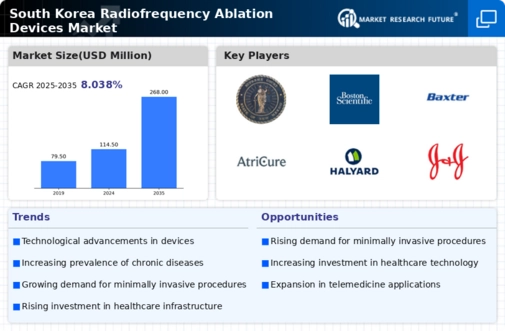Aging Population and Associated Health Issues
The demographic shift towards an aging population in South Korea is significantly impacting the radiofrequency ablation-devices market. As the population ages, the prevalence of chronic conditions such as cardiovascular diseases and cancer increases, necessitating effective treatment options. It is estimated that by 2030, over 20% of South Korea's population will be over 65 years old, which correlates with a rising demand for radiofrequency ablation procedures. This demographic trend suggests a sustained growth trajectory for the market, as healthcare providers seek to implement advanced treatment modalities to address the complex health needs of older patients. Consequently, the radiofrequency ablation-devices market is poised for expansion in response to these demographic changes.
Rising Demand for Minimally Invasive Procedures
The radiofrequency ablation-devices market is experiencing a notable surge in demand for minimally invasive procedures. Patients and healthcare providers are increasingly favoring techniques that reduce recovery time and minimize surgical risks. In South Korea, the healthcare system is evolving to accommodate these preferences, leading to a projected growth rate of approximately 8% annually in the radiofrequency ablation-devices market. This trend is driven by advancements in technology that enhance the efficacy and safety of these procedures, making them more appealing to both patients and practitioners. As a result, the market is likely to expand as more healthcare facilities adopt these innovative solutions, reflecting a shift towards patient-centered care in the medical landscape.
Increased Investment in Healthcare Infrastructure
Investment in healthcare infrastructure in South Korea is a critical driver for the radiofrequency ablation-devices market. The government and private sector are channeling substantial resources into modernizing healthcare facilities and expanding access to advanced medical technologies. This investment is expected to enhance the availability of radiofrequency ablation devices, thereby facilitating their adoption in clinical settings. Reports indicate that healthcare spending in South Korea is projected to reach $200 billion by 2025, with a significant portion allocated to innovative medical technologies. As healthcare facilities upgrade their equipment and capabilities, the radiofrequency ablation-devices market is likely to benefit from increased utilization and improved patient outcomes.
Technological Innovations Enhancing Device Efficacy
Technological innovations are playing a pivotal role in shaping the radiofrequency ablation-devices market. Continuous advancements in device design and functionality are enhancing the precision and effectiveness of ablation procedures. In South Korea, manufacturers are investing in research and development to create next-generation devices that offer improved outcomes and reduced complications. For instance, the introduction of real-time imaging and navigation systems is revolutionizing the way ablation procedures are performed. This focus on innovation is likely to attract more healthcare providers to adopt radiofrequency ablation techniques, thereby propelling market growth. As technology continues to evolve, the radiofrequency ablation-devices market is expected to expand in response to these advancements.
Growing Awareness and Education on Treatment Options
There is a growing awareness among both healthcare professionals and patients regarding the benefits of radiofrequency ablation procedures. Educational initiatives and outreach programs are being implemented to inform stakeholders about the advantages of these treatments, which include reduced pain and shorter recovery times. In South Korea, healthcare providers are increasingly incorporating radiofrequency ablation into their treatment protocols, leading to a rise in patient inquiries and acceptance of these procedures. This heightened awareness is expected to drive demand in the radiofrequency ablation-devices market, as more patients seek out these innovative solutions for managing chronic conditions. The market could see a significant uptick as educational efforts continue to expand.

















Leave a Comment